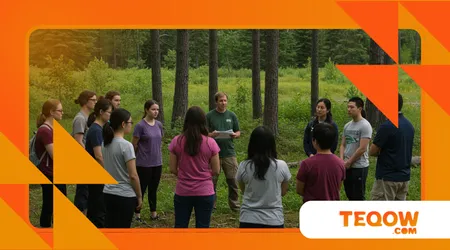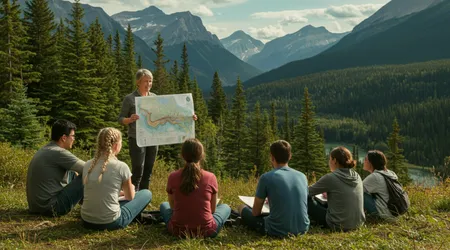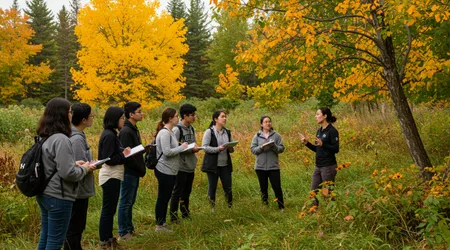Outdoor Education and Experiential Learning in Canada

Outdoor Education and Experiential Learning surges forward in Canada, blending adventure with academics amid 2025’s push for resilient minds.
Educators champion this shift, arguing it counters screen fatigue. Students grasp concepts through sweat and discovery, not rote memorization. Why chain young brains to chairs when trails beckon?
Recent initiatives spotlight urgency. Outward Bound Canada’s fully-funded workshops, launched September 2025, equip teachers with tools for immersive trips. These sessions stress group dynamics, igniting passion for nature-based curricula.
Critics once dismissed it as “playtime,” but data flips that script. A June 2025 study reveals two hours daily outdoors slashes teen anxiety by 30%. Parents nod; schools invest.
This approach thrives because Canada boasts vast playgrounds from Rockies’ peaks to Atlantic shores. Policymakers weave it into national strategies, eyeing holistic growth.
Yet, integration demands creativity. Teachers adapt urban constraints, turning parks into classrooms. Outdoor Education and Experiential Learning evolves, proving adaptable in diverse settings.
Skeptics question scalability. Fair point rural access outpaces city limits. Still, hybrid models bridge gaps, ensuring equity.
Forward thinkers predict boom times. With climate woes mounting, experiential methods foster stewards, not spectators. Canada’s youth deserve this edge.
The Compelling Benefits That Demand Attention
Active voices in education swear by Outdoor Education and Experiential Learning. Kids build resilience navigating muddy hikes, forging bonds stronger than any team-building exercise.
Mental health leaps forward. That 2025 research underscores how outdoor time combats isolation, boosting focus and joy in equal measure. Teens report sharper problem-solving after wilderness weeks.
Physical gains shine too. Students hike, paddle, and climb, shedding sedentary habits. Bodies strengthen; confidence soars as fears fade.
Environmentally, awareness deepens. Participants spot ecosystem intricacies, urging sustainable choices back home. It’s stewardship sown in soil.
++ Top 10 Fintechs Canadian Students Are Using to Manage Money
Socially, inclusivity blooms. Diverse groups collaborate, dismantling biases through shared triumphs. Friendships form amid campfires’ glow.
One original example: In Alberta’s foothills, a Grade 8 class maps invasive species, debating eradication tactics. They act, restoring a creek real impact, raw learning.
Another: Nova Scotia youth simulate Indigenous harvesting, tasting berries while pondering cultural ties. Hands-on history sticks forever. These perks argue fiercely against outdated models. Why ignore nature’s classroom when it molds leaders?

Spotlight on Thriving Programs Across Provinces
British Columbia leads with Vancouver Outdoor School’s field studies. Kids explore beaches and trails, dissecting marine life under expert guides. Sessions run year-round, adapting to tides.
Ontario’s Muskoka Woods dives into life skills. Campers cook over fires, navigate lakes—essentials for independence. Programs target holistic development, blending fun with facts.
Quebec’s Queen’s University crafts teacher tracks in Outdoor Education and Experiential Learning. Candidates design expeditions, testing theories in wilds. Grads transform classrooms nationwide.
Durham District School Board’s centres host grades 2-12. Duffins Creek site immerses pupils in forests, tracking wildlife patterns. Hands dirty, minds alive.
Also read: Co-op Programs in Canada: Study and Work Experience Combined
Alberta’s Royal Roads University probes transformative methods. Courses tackle curriculum integration, sparking innovative field trips. Faculty push boundaries, inspiring replication.
Take Me Outside’s 2025 Leadership Conference gathers 250 admins at Banff. Discussions fuel policy shifts, amplifying reach. Momentum builds organically.
These hubs prove viability. Provinces tailor to terrains, maximizing local gems. Scalability? Absolutely, with shared blueprints.
Innovative Twists Reshaping the Landscape
Tech weaves into wilderness now. Drones scout trails; apps log biodiversity Outdoor Education and Experiential Learning goes digital without losing soul.
Indigenous partnerships enrich narratives. Elders guide ceremonies, weaving cultural threads into ecology lessons. Respectful fusion honors history.
Hybrid formats explode post-pandemic. Virtual prep meets in-person quests, easing urban-rural divides. Flexibility wins converts.
Read more: How Canada’s Education System Compares Globally
Micro-credentials emerge, like UCalgary’s Ready for Research. Students earn badges via outdoor inquiries, boosting resumes. Practical edge for job hunts. Community tie-ins amplify. Schools link with parks, co-hosting cleanups. Locals mentor, fostering lifelong advocates.
One clever pivot: Toronto pilots rooftop gardens as mini-expeditions. City kids harvest, analyze soil urban adaptation at its finest.
Another: Manitoba’s VR-enhanced canoe trips simulate routes for weather-hit days. Innovation keeps momentum rolling. These riffs counter stagnation claims. Why cling to chalkboards when gadgets and traditions turbocharge engagement?
Navigating Challenges with Smart Strategies

Weather throws curveballs rain soaks plans, snow halts treks. Educators scout backups, like indoor simulations mirroring outdoors. Preparation trumps peril.
Equity gaps loom large. Low-income families lack gear; remote spots hinder access. Grants level fields, subsidizing trips. Inclusion demands investment.
Teacher burnout surfaces. Voluntary roles drain energy. Training workshops, like Outward Bound’s 2025 offerings, recharge batteries. Support sustains passion.
Risk perceptions scare admins. Yet, stats show outdoor play injures less than sports. Education demystifies dangers.
Funding fights persist. Budget cuts nibble edges. Advocacy rallies, like Take Me Outside’s, secure pots. Voices unite for victory. Urban sprawl squeezes green spaces. Creative hacks pop-up parks, trail apps reclaim corners. Persistence pays.
These hurdles? Mere speed bumps. Smart pivots turn obstacles into opportunities, strengthening resolve.
| Province | Key Program | Focus Areas | Participant Age | Annual Reach (Est. 2025) |
|---|---|---|---|---|
| British Columbia | Vancouver Outdoor School | Marine ecology, hiking | K-12 | 5,000+ students |
| Ontario | Muskoka Woods | Life skills, canoeing | 8-18 | 3,200 campers |
| Quebec | Queen’s University OEE Track | Teacher training, expeditions | Pre-service educators | 150 candidates |
| Alberta | Royal Roads University OEE | Curriculum integration | University level | 200 enrollees |
| Nova Scotia | Indigenous-Led Harvest Simulations | Cultural ecology | Grades 6-10 | 800 participants |
This snapshot highlights diversity, drawn from ongoing 2025 enrollments.
Charting the Future: Bold Visions Ahead
Policy winds favor expansion. Federal frameworks, eyed for 2026, embed Outdoor Education and Experiential Learning in core standards. Momentum accelerates.
Climate curricula integrate seamlessly. Students model carbon cycles via forest plots, grasping urgency firsthand.
Global exchanges bloom. Canadian programs twin with Nordic models, swapping tactics across borders. Cross-pollination sparks genius.
Corporate sponsorships rise. Firms fund eco-challenges, tying branding to green ethos. Win-win for all. Youth-led initiatives surge. Teens design apps tracking trail ethics, owning their learning arcs.
One visionary leap: AI predicts optimal outing days, factoring weather and moods. Tech serves nature, not supplants. Another: Nationwide “Wild Weeks” mandate one outdoor immersion per term. Uniform push, varied executions.
These horizons thrill. Experiential learning mirrors planting seeds in fertile soil you nurture, watch empires grow. Why doubt its yield?
Wrapping Up: A Call to Step Outside
Outdoor Education and Experiential Learning isn’t fad it’s foundation. Canada’s landscapes gift unparalleled labs; we must seize them.
From mental boosts to eco-warriors, gains stack high. That stark stat under 5% of teens hit two outdoor hours daily screams for action. Flip it, unlock potential.
Parents, probe school offerings. Teachers, pitch bold trips. Leaders, allocate funds wisely. Rhetorically, isn’t it time we trade fluorescent hums for wind whispers? Nature awaits, whispering wisdom.
This path promises equipped generation resilient, rooted, ready. Step out; the world sharpens in sunlight.
Frequently Asked Questions
What makes Outdoor Education and Experiential Learning suitable for all ages?
It scales effortlessly toddlers toddle trails, teens tackle treks. Adaptations ensure broad appeal.
How do I get my school involved in Canadian programs?
Scan provincial boards; apply via sites like Outward Bound. Grants ease entry.
Are there costs for families?
Many subsidize fully. Check equity funds for low-income access.
Does bad weather cancel everything?
Nope plans pivot to covered spots or virtual extensions. Flexibility rules.
